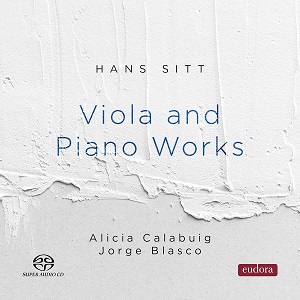
Hans Sitt (1850-1922)
Viola and Piano Works
Albumblätter, Op 39 (1891)
Fantasiestücke, Op 58 (1894)
Romance, Op 72 (c.1900)
Morceaux, Op 75 (1901)
Drei Stücke, Op 102 No 1: Romance (1910)
Gavotte and Mazurka, Op 132 (1919)
Alicia Calabuig (viola)
Jorge Blasco (piano)
rec. 2021, Auditorio de Zaragoza, Sala Mozart
Eudora EUDDR2305 SACD [64]
Violinist Hans Sitt was born Jan Hanuš Sitt in Prague and had an elite career in Germany as a concertmaster and later as the most eminent violin teacher in Leipzig but he is best-remembered for being the violist in Adolf Brodsky’s Quartet, with whom he played for twelve years.
As with many executants of the period, he also composed. In Sitt’s case he wrote modest little character pieces, salon-orientated and small-scaled, avoiding virtuoso showpieces of the Paganini-Ernst-Vieuxtemps kind. Sitt was an altogether more clement personality – he taught Delius, Alfano and Talich amongst many others during his decades in Leipzig – and inclined more to the romances, album pieces and carte-de-visite compositions that were so popular at the time. If you, too, have a yen for this post-Schumannesque genre, then Sitt is very much your kind of composer.
The earliest piece here is the set of six Albumblätter, Op 39, composed in 1891 when Sitt was 41. These are suffused with mellifluous lyricism and charm, alternating occasionally with rather more athletic but still salon-inclined dexterity. The fifth piece is the most pensive but this is as far as Sitt will go, ending the set with a kind of moto perpetuo charmer. The Fantasiestücke, Op 58 offer three well-contrasted pieces that call for slightly more outgoing playing. The opening is tinged with agitato writing and this is followed by a wholesome Andante, a song-without-words that evokes Schumann in its romance-oriented warmth. The exchanges between the two instruments in these three pieces are slightly more developed than in the Op 39 set.
The larger-scaled Romance, Op 72 is a richly textured piece whereas the three Morceaux, Op.75 offer an earnest, slightly Brahmsian Elegie, a reflective Rêverie – the tempo similarities between these two pieces suggests that this set may not have been performed in full, but Sitt may have selected from his works when he performed them – and there’s an easy-going Barcarolle, with a lively B section, to finish.
The Romance, Op 102 was originally written for violin and piano and offers an elegant string line and supportive chordal writing for the piano. Finally, there is the Gavotte and Mazurka, written in 1919 and possibly taking advantage of the fondness for Baroquerie at the time, though this isn’t that kind of work exactly. Rather, the Gavotte is gently witty, the Mazurka charmingly cosmopolitan.
Ann Marie Brink (viola) and Marta Aznavoorian (piano) recorded an almost identical programme for Centaur though it’s seemingly only available as a download. I’ve not heard it, though I know the pianist’s work and admire her.
The booklet note is well compiled and is in English and Spanish, whilst the SACD recording, to which I listened on a conventional setup, is most attractive. Alicia Calabuig is a clean-cut violist with a fine, unshowy technique. She’s not the most evocative tonalist and her range of tone colours is rather limited but in compensation she is never guilty of inflating these pieces beyond their natural self-imposed limits. Pianist Jorge Blasco proves a supportive colleague, snatching rare opportunities to demonstrate an extrovert personality, when Sitt allows him the chance.
Jonathan Woolf
Help us financially by purchasing from



















